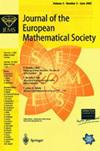Does Leray’s structure theorem withstand buoyancy-driven chemotaxis-fluid interaction?
IF 2.9
1区 数学
Q1 MATHEMATICS
引用次数: 15
Abstract
In a smoothly bounded convex domain Ω ⊂ R, we consider the chemotaxis-Navier-Stokes model nt + u · ∇n = ∆n−∇ · (n∇c), x ∈ Ω, t > 0, ct + u · ∇c = ∆c− nc, x ∈ Ω, t > 0, ut + (u · ∇)u = ∆u+∇P + n∇Φ, ∇ · u = 0, x ∈ Ω, t > 0, (⋆) proposed by Goldstein et al. to describe pattern formation in populations of aerobic bacteria interacting with their liquid environment via transport and buoyancy. Known results have asserted that under appropriate regularity assumptions on Φ and the initial data, a corresponding no-flux/noflux/Dirichlet initial-boundary value problem is globally solvable in a framework of so-called weak energy solutions, and that any such solution eventually becomes smooth and classical. Going beyond this, the present work focuses on the possible extent of unboundedness phenomena also on short timescales, and hence investigates in more detail the set of times in (0,∞) at which solutions may develop singularities. The main results in this direction reveal the existence of a global weak energy solution which coincides with a smooth function throughout Ω × E, where E denotes a countable union of open intervals which is such that |(0,∞) \ E| = 0. In particular, this indicates that a similar feature of the unperturbed Navier-Stokes equations, known as Leray’s structure theorem, persists even in the presence of the coupling to the attractive and hence potentially destabilizing cross-diffusive mechanism in the full system (⋆).勒雷的结构定理经得起浮力驱动的趋化-流体相互作用吗?
顺利的有界凸域Ω⊂R,我们认为chemotaxis-Navier-Stokes模型nt + u·∇n =∆n−∇·(n∇c), x∈Ω,t > 0, ct + u·∇c = c∆−数控,x∈Ω,t > 0, ut + (u·∇)u =∆u +∇P + n∇Φ,∇·u = 0, x∈Ω,t > 0,(⋆)戈尔茨坦等人提出的描述模式形成好氧细菌的数量与液体环境交互通过运输和浮力。已知的结果表明,在Φ和初始数据上适当的正则性假设下,相应的无通量/无通量/Dirichlet初边值问题在所谓的弱能量解框架下是全局可解的,并且任何这样的解最终都是光滑的和经典的。除此之外,目前的工作重点是在短时间尺度上无界现象的可能程度,因此更详细地研究了(0,∞)中解可能发展为奇点的时间集。在这个方向上的主要结果揭示了一个全局弱能量解的存在性,它与整个Ω × E中的光滑函数重合,其中E表示开区间的可数并,使得|(0,∞)\ E| = 0。特别是,这表明无扰动Navier-Stokes方程的一个类似特征,即Leray结构定理,即使在整个系统中存在与吸引机制的耦合并因此潜在地破坏稳定的交叉扩散机制的情况下仍然存在(—)。
本文章由计算机程序翻译,如有差异,请以英文原文为准。
求助全文
约1分钟内获得全文
求助全文
来源期刊
CiteScore
4.50
自引率
0.00%
发文量
103
审稿时长
6-12 weeks
期刊介绍:
The Journal of the European Mathematical Society (JEMS) is the official journal of the EMS.
The Society, founded in 1990, works at promoting joint scientific efforts between the many different structures that characterize European mathematics. JEMS will publish research articles in all active areas of pure and applied mathematics. These will be selected by a distinguished, international board of editors for their outstanding quality and interest, according to the highest international standards.
Occasionally, substantial survey papers on topics of exceptional interest will also be published. Starting in 1999, the Journal was published by Springer-Verlag until the end of 2003. Since 2004 it is published by the EMS Publishing House. The first Editor-in-Chief of the Journal was J. Jost, succeeded by H. Brezis in 2004.
The Journal of the European Mathematical Society is covered in:
Mathematical Reviews (MR), Current Mathematical Publications (CMP), MathSciNet, Zentralblatt für Mathematik, Zentralblatt MATH Database, Science Citation Index (SCI), Science Citation Index Expanded (SCIE), CompuMath Citation Index (CMCI), Current Contents/Physical, Chemical & Earth Sciences (CC/PC&ES), ISI Alerting Services, Journal Citation Reports/Science Edition, Web of Science.

 求助内容:
求助内容: 应助结果提醒方式:
应助结果提醒方式:


